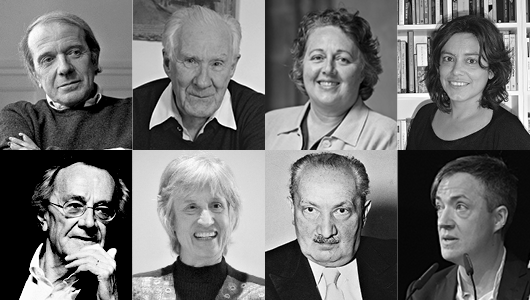Event â When the self
and the field
become for a while one

Gilles Deleuze, Alain Badiou, Rosi Braidotti, Sara Ahmed, Jean-François Lyotard, Donna Haraway, Martin Heidegger, Paul B. Preciado
In this PhD thesis (School of Business and Management, Queen Mary University of London, United Kingdom), I address ephemeras â namely temporary displays in the form of festivals and exhibitions developed in and belonging to the field of contemporary art. The word âephemeraâ is fitting here because it avoids any sense of spectacle or entertainment, and thus suits the data that I have chosen to analyse. But how to discuss ephemeras, namely time-based artistic productions, materialised in a variety of media and formats of expression?
I have found that the most appropriate criterion with which to select and discuss the ephemera, i.e., the data in which I analyse in this thesis, is the notion of the âeventâ. In the sense in which I use the word here, âeventâ is a philosophical concept, and therefore does not belong to artistic or aesthetic categories. However, two main characteristics are particularly relevant in considering the concept of event, and these are also pertinent to the field of art. Firstly, the tandem contingency and necessity. Secondly, the fact that no one can control the reach and impact of an event, which is also the case with an artwork and its interpretation. Interestingly enough, this interaction and exchange between event and artwork has nothing to do with the participative dynamic, but is a spontaneous reaction between two distinguishable entities, leading to unpredictable production: of thought, of feeling, of memory in the case of the event; of analysis, discursivity and creation in the case of art.
One of my main interests in writing this thesis is to create a confrontation between what is usually described as abstract thought (such as logic or mental inquiry â a work of philosophy for example) and the production of contemporary art, which is so often culturally and economically dependent on the art market and hegemonic power structures such as the institutions responsible for its conservation and archiving, as well as the apparatus of historians and experts to valuate and legitimise it. Philosophical concepts allow an escape from such materiality.
At this early stage of the discussion, it is also necessary to state my understanding of art and the way it has been practised through the ephemeral events that are the objects of my interest in this paper. The art to which I allude in this thesis has strong propinquities with that defined by Kant when he coined the term âfine artâ, 1 namely a cultivated, context-aware and sensitive art, oneâs reflection on which provides pleasure exceeding the pure enjoyment or satisfaction produced by erudition or technical virtuosity. Secondly, the artistic manifestations that I discuss in this paper are always produced by a collective, group or organisation of which I am part. Consequently, what will happen during the unfolding of these chapters is an organisational discourse 2 originating in my praxis of art. Furthermore, the very fact that I am a member of the group of people whose activities are discussed leads logically to autoethnography, âa field of inquiry that has become eclectic, to say the least. Nevertheless, in all autoethnographic work, in some way or other, âthe self and the field become oneâ.â 3
1 | âFine art in its full perfection requires much science: e.g., we must know ancient languages, we must have read the authors considered classical, we must know history and be familiar with the antiquities, etc. [âŠ] If art merely performs the acts that are required to make a possible object actual, adequately to our cognition of that object, then it is mechanical art; but if what it intends directly is [to arouse] the feeling of pleasure, then it is called aesthetic art. The latter is either agreeable or fine art. [âŠ] It is fine art if its purpose is that the pleasure should accompany presentations that are ways of cognizing (Erkenntnisarten). [âŠ] Fine art [âŠ] is a way of presenting that is purposive on its own and that furthers, even without a purpose, the culture of our mental powers to [facilitate] social communication. The very concept of the universal communicability of a pleasure carries with it [the requirement] that this pleasure must be a pleasure of reflection rather than one of enjoyment arising from mere sensation. Hence aesthetic art that is also fine art is one whose standard is the reflective power of judgment, rather than sensation proper.â, Emmanuel Kant, Critique of Judgment, trans. Werner S. Pluhar, Indianapolis/Cambridge, Indiana, 1987, § 43â50, in particular § 44, Fine Art, pp. 172â173. |
2 | Cynthia Hardy, Thomas B. Lawrence, David Grant, âDiscourse and collaboration: the role of conversation and collective identityâ, in Academy of Management Review, Vol. 30, No. 1, Briarcliff Manor, New York, 2005, p. 60. |
3 | Mark Learmonth and Michael Humphreys, âAutoethnography and academic identity: glimpsing business school doppelgĂ€ngersâ, in Organization, 19 (1), Sage, London, 2011, p. 103. They quote Amanda Coffey, âEthnography and Self: Reflections and Representationsâ, in T. May (ed.) Qualitative Research in Action, Sage, London, 2002, p. 320. |